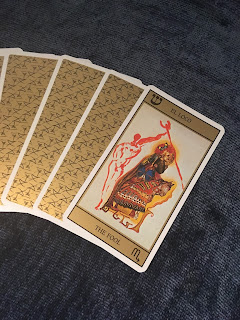Making Use of Allusions in Tarot & Fiction
Allusions are indirect references to characters, places, images, and concepts from other sources, or references to the sources themselves, like literature, art, film, or history—especially famous or important works.
For the following example, I’ll be reading for the main character in my novel-in-progress. I reverse drew the High Priestess to represent my protagonist, Persephone, because the card traditionally depicts the Ancient Greek goddess of nature. I'm using the Rider-Waite version as a reference here since it’s the most common image for this card.
The pomegranate motif behind the priestess is the symbol of Persephone, who ate the fruit’s seeds while trapped in the Underworld, dooming herself to return every year to live among the dead. The fruit represents fertility likely due to its seeds appearing like ova, and the spiked corona at the top symbolizes divine rule.
Tarot is full of allusions to Greek mythology, Jewish mysticism, and the Bible because they’ve so heavily influenced Western culture. Allusions to religion and history imbue the cards with a deeper symbolic power, creating layers of meaning that can interact with each other in numerous ways no matter how you interpret them.
As writers, we can learn from the tarot as a medium not only for divination and story-telling, but for self-reflection and cultural analysis.
For the following example, I’ll be reading for the main character in my novel-in-progress. I reverse drew the High Priestess to represent my protagonist, Persephone, because the card traditionally depicts the Ancient Greek goddess of nature. I'm using the Rider-Waite version as a reference here since it’s the most common image for this card.
Example: The High Priestess & Greek Myth
| The High Priestess alludes to the goddess Persephone |
In her lap, she holds the Torah, the sacred Jewish text and the Old Testament part of the Bible, which imparts upon her God’s knowledge. (It’s common for Tarot to have allusions to multiple mythologies, especially because the Occult movement in Europe borrowed heavily from Ancient Greek and Roman beliefs as well as Judaism, Christianity, and folk practices.)
The crescent images allude to the traditional, cis-normative link between womanhood and the moon, and by extension lunar goddesses like Artemis or Hekate. Her crown creates three facets of the moon, symbolizing a divine trifecta of three goddesses, or the maiden-mother-crone archetypes. (Personally, I see the crescents removed from gendered associations as a symbol of cyclic change and transformations like the lunar phases.)
Some call this the “divine feminine” card, but I feel that this reinforces cis-heteronormative interpretations that limit the symbols’ complexities to a strict gender binary, which in turn reduces the card to a collection of sexist stereotypes.
Instead, I view the allusions in this card as stepping stones to creating more complex meanings. The High Priestess doesn’t have to represent a cis female character, and the associations with fertility, the moon, and nature aren’t exclusive to femininity. At its core, this card is about intuition, self-knowledge, connection to nature, and mystic power.


Comments
Post a Comment